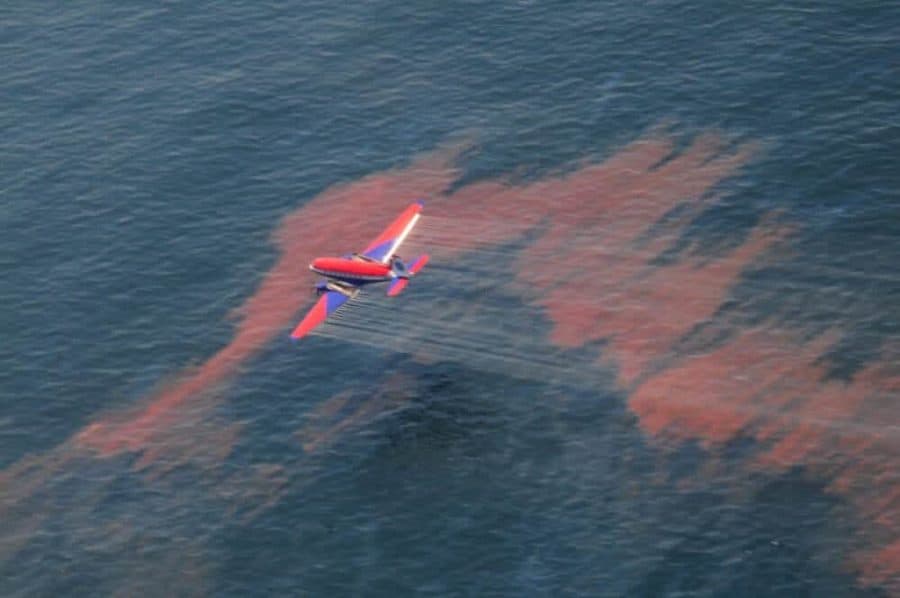A new study shows that sunlight transforms oil spills on the ocean surface more quickly and significantly than previously thought, limiting the effectiveness of chemical dispersants that break up floating oil.
A research team funded by the National Science Foundation (NSF) and led by the Woods Hole Oceanographic Institution (WHOI) found that sunlight chemically alters crude oil floating on the sea surface within days or hours.
The team reported that sunlight changes oil into different compounds that dispersants cannot easily break up. The findings, published today in the journal Environmental Science & Technology Letters, could affect how responders decide when, where and how to use dispersants.
“It’s been thought that sunlight has a negligible impact on the effectiveness of dispersants,” said Collin Ward, a scientist at WHOI and lead author of the study. “Our findings show that sunlight is a primary factor that controls how well dispersants perform. And because photochemical changes happen fast, they limit the window of opportunity to apply dispersants effectively.”
Added Henrietta Edmonds, a program director in NSF’s Division of Ocean Sciences, which funded the research, “This study shows how important it is to do basic research on the chemical reactions that take place in the environment. The results will help us learn how to effectively respond to oil spills.”
Oil and water: no mixing in the sea
Dispersants contain detergents, not unlike those people use to wash dishes, which help break oil into small droplets that are diluted in the ocean or are eaten by microbes before the oil can be swept to sensitive coastlines. But to do their work, the detergents (also known as surfactants) first need to mix with both the oil and water — and oil and water, famously, don’t mix.
To overcome this barrier, dispersants contain an organic solvent that helps the oil, detergents and water mix. Only when this step happens can the surfactants do their work to break oil into droplets. But sunlight obstructs this step, the new study shows.
Before dispersants can be applied, light energy from the sun immediately begins to break chemical bonds in oil compounds — splitting off atoms or chemical chains and creating openings for oxygen to attach. This photo-oxidation process (also known as photochemical “weathering”) is similar to the process that causes paint on cars or colors on clothes to fade if they are left out in the sun for too long.
To date, tests to determine the effectiveness of dispersants used only “fresh” oil that hadn’t been altered by sunlight. In the new study, the researchers conducted extensive lab tests exposing oil to sunlight. They showed that sunlight rapidly transforms oil into residues that are only partially soluble in a dispersant’s solvent, limiting the ability of detergents to mix with the photo-oxidized oil and break the oil into droplets.
New ‘window of opportunity’ estimate needed
The finding suggests that responders should factor in sunlight when determining the “window of opportunity” to use dispersants effectively. That window is far smaller on sunny days than previously thought.
“This study challenges the paradigm that photochemical weathering has a negligible impact on the effectiveness of aerial dispersants applied in response to oil spills,” Ward said. “Sunlight rapidly alters oil into chemical compounds that dispersants can’t easily break up into droplets. So photochemical weathering is a critical factor that should be considered to optimize decisions on when to use dispersants.”
The continuous flow from the 2010 Deepwater Horizon disaster in the Gulf of Mexico provided a unique opportunity to study the effects of sunlight on oil. Because oil floated on the sea surface for 102 days, it gave officials a chance to collect oil shortly after it surfaced and was exposed to sunlight.
Testing oil, water — and sunlight
The WHOI scientists obtained and tested samples of Deepwater Horizon oil that was skimmed from the surface almost immediately after it appeared. They found that the longer the oil floated on the sunlit sea surface, the more the oil was photo-oxidized. They estimated that half the spilled oil had been altered within days.
The next step was to test how the photo-oxidized oil would respond to dispersants. The scientists tested fresh, unaltered Deepwater Horizon oil that was collected directly from the broken riser pipe on the seafloor.
They controlled laboratory conditions to prevent temperature changes, evaporation, light infiltration and other factors, and they exposed the oil to increasing durations of light. Cassia Armstrong, a guest student from Trinity College, played a key role in conducting these tests and is a co-author of the paper.
Sunlight reduces dispersant effectiveness
Results of the experiments showed that light rapidly photo-oxidized the fresh oil, changing it within a few days into compounds that reduced the effectiveness of dispersants by at least 30 percent.
The scientists teamed with Deborah French McCay, an oil spill modeler at RPS ASA, a science and technology consulting firm in Rhode Island. The researchers simulated conditions that might have occurred during the Deepwater Horizon spill, including a range of wind speeds and sunlight levels. Then they superimposed the 412 flight lines of planes that sprayed dispersants during the crisis.
The results showed that because they targeted photochemically-weathered oil, the majority of dispersant applications would not have achieved minimum effectiveness levels under average wind and sunlight conditions.
Even under the best-case scenarios for aerial dispersant spraying — cloudy weather (which would limit photochemical weathering) and high-wind conditions (which would transport oil farther from the spill before sunlight transformed it) — dozens of aerial dispersant applications still would not have achieved designated effectiveness levels.
“We assembled a team that combined the expertise of academia, government and industry researchers,” explained Christopher Reddy, a marine chemist at WHOI. “In future oil spill crises, the community needs the same kind of cooperation and collaboration to make the wisest decisions on how to respond most effectively.”
The research was also funded by the Gulf of Mexico Research Initiative, and the DEEP-C (Deep Sea to Coast Connectivity in the Eastern Gulf of Mexico) Consortium.


